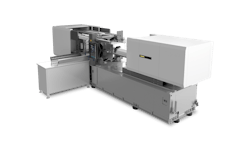By Karen Hanna
Canon Virginia Inc. (CVI), a subsidiary of Canon Inc., known for its copiers, scanners, cameras and other products, has reduced the size of its shuttle mold system, which rotates two molds in and out of one press every cycle. The strategy allows the machine to mold one part while the other is still cooling.
“So, essentially, it has the capability of outproducing a single machine 2-to-1,” said Wayne Daniel, director of business development. “If we can do that, then machine efficiency goes up 200 percent.”
Designed in 2014 for use with machines making inkjet printer parts, the shuttle mold system is available in two sizes, supporting all new presses with clamping forces of about 200 tons to 700 tons. This year, Canon upgraded the machinery that moves the molds and reduced the size of the units by 30 percent. Next year, it plans to roll out units that can work with presses with up to 1,000 tons of clamping force.
Daniel said Canon first brought the technology to market last year, after showing it at NPE2018.
“We didn’t have any intention of selling it, actually, but it generated so much interest back then in 2018, we decided to proceed with commercialization,” he said.
He said the units most often are installed by injection molding machine makers, though they can be retrofitted. They’re appropriate for applications that require relatively long cycle times, of about 30 seconds or more, when there’s ample cooling time.
Typical applications involve relatively large parts or thick-walled parts for markets such as the automotive or construction industries.
Using Canon software integrated with machine control software from the OEM, the shuttle mold system can manage molds for either the same part, or different parts, as long as they use the same materials.
In some cases, he said, users might choose to run parts that can be assembled together either in the mold or after molding operations, eliminating the need for managing inventory for separate stocks of related parts.
In other cases, the Shuttle Mold might be installed on a press to make totally unrelated parts.
“Everything is done within the same cycle, two different parts, one machine,” Daniel said.
Compatible with all makes of machines, the shuttle mold system needs room to move, so setups that require bulky hydraulics or other potential obstacles would not be a good fit. Molds must use standardized clamping plates.
The system does not interfere with waterlines and causes no hindrance to auxiliary equipment, such as robots, Daniel said.
“From a machine point of view, as long as the machine manufacturer can do the integration of the software and the hardware to their machine and controller, then it’s really applicable to any [molding] machine. It doesn’t have to be custom, or anything like that,” Daniel said.
The software can handle separate process conditions for each mold independently, he said.
“The machine really doesn’t care, so the machine and the software just switches from Mold A to Mold B … so that process condition follows Mold A or Mold B.”
The screw recovers during each mold switchover.
Operators can turn off the shuttle mold system, allowing the machine to run just one mold at a time. They also can remove the system easily, though Daniel cautioned that installing and re-aligning it are tricky.
With the shuttle molds, plants can squeeze more out of their machines, without having to buy additional presses and accompanying auxiliary equipment. Daniel pointed to an in-house example, in which Canon had tried to reduce part cost by 50 percent, using the shuttle mold system; the plant hit 40 percent.
With the goal of making more money from each square foot, the system isn’t like having an exact copy of a second press, but, according to the company, it might be just as productive.
“One of the selling points of this system is that if you’re limited on space, you don’t have the room to add a second machine, the shuttle mold then basically gives you the benefit of two machines but taking up the space for a little bit more than one,” Daniel said.
Karen Hanna, associate editor
Contact:
Canon Virginia Inc., Newport News, Va., 757-881-6001, https://cvi.canon.com/manufacturing-services/shuttle-mold
About the Author
Karen Hanna
Senior Staff Reporter
Senior Staff Reporter Karen Hanna covers injection molding, molds and tooling, processors, workforce and other topics, and writes features including In Other Words and Problem Solved for Plastics Machinery & Manufacturing, Plastics Recycling and The Journal of Blow Molding. She has more than 15 years of experience in daily and magazine journalism.
